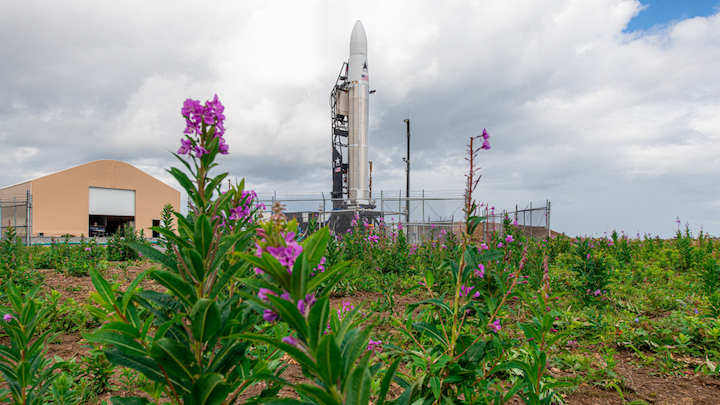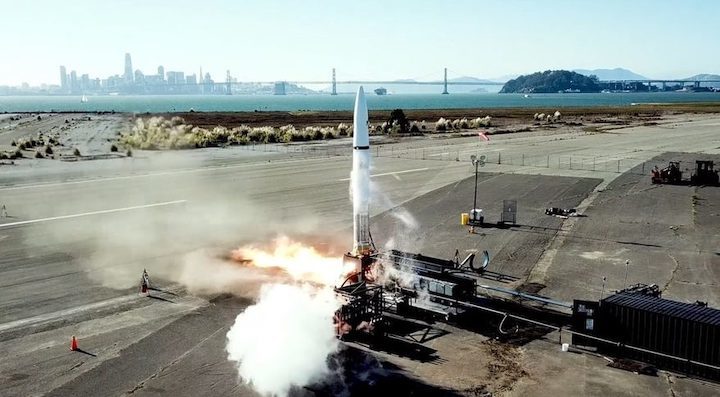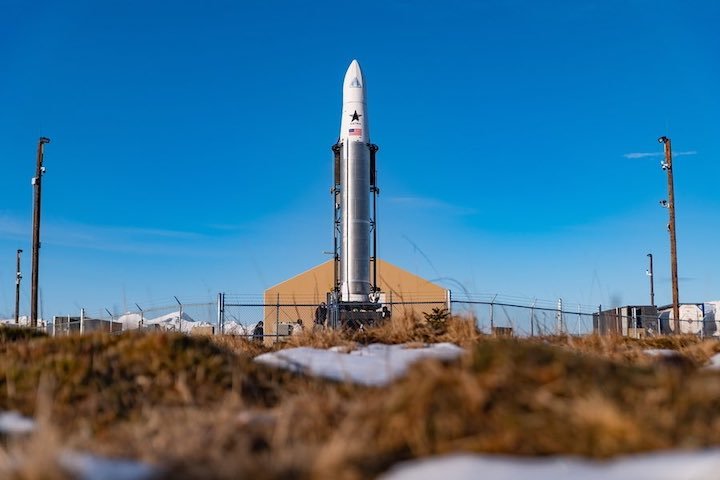25.07.2020

Astra’s next small satellite launcher has shipped to Kodiak Island in Alaska for final preparations ahead of a test flight planned in early August, five months after the company’s first orbital rocket faltered before getting off the ground.
The small launch company, headquartered in Alameda, California, announced Monday that the mission’s six-day launch window opens Aug. 2. Astra will have a launch opportunity between 3:30 p.m. and 7 p.m. EDT (1930 and 2300 GMT) each day.
The new two-stage launch vehicle, which the company calls Rocket 3.1, will take off from the Pacific Spaceport Complex on Kodiak Island. While the liquid-fueled rocket is designed to reach orbit, Astra says it will consider the test flight a success even it doesn’t enter orbit.
“Success for this flight means we accomplish enough to make orbit within three flights, which we have defined as at least achieving a nominal first stage burn,” Astra said in June.
Chris Kemp, Astra’s co-founder and CEO, said the company will not be providing a live video stream of the launch to the public, but will release video imagery of the flight after it occurs.
“We do not yet employ production, marketing, or communications folks, so our ability to produce a public webcast is limited,” Kemp said in response to questions from Spaceflight Now. “We are focusing all resources on engineering so that we can reach orbit in the next couple of flights.”
The design of Rocket 3.1 is based on a launch vehicle Astra sent to Kodiak earlier this year for a launch campaign that was part of the Defense Advanced Research Projects Agency’s Launch Challenge. The DARPA Launch Challenge, managed by the Pentagon’s research and development agency, was conceived to incentivize development of new responsive commercial U.S. launch systems.
DARPA offered up to $12 million prize money to a company that demonstrated its ability to launch a small payload to low Earth orbit on short notice, then perform the same feat from a different launch pad less than a month later.
The deadline for the first of two Astra missions under DARPA’s Launch Challenge was March 2. After several weather delays and other schedule slips in late February, Astra fueled its Rocket 3.0 vehicle on an austere launch pad at Kodiak on the final day of the challenge March 2.
But Astra scrubbed a launch attempt due to suspect data detected from the rocket’s guidance, navigation and control system.
The March 2 launch attempt was streamed live on Internet, but that production was managed by DARPA, not Astra.

Astra was set to try again to launch Rocket 3.0 from Kodiak later in March outside the realm of the DARPA Launch Challenge, but the vehicle “experienced an anomaly” during pre-flight testing on the launch pad, Kemp said at the time.
Satellite imagery of the launch facility on Kodiak Island showed burn scars, suggesting the rocket may have exploded or caught fire. Kemp said no payloads were on-board the rocket during the accident.
Founded in 2016, Astra operated in stealth mode until earlier this year.
The company says its rockets can launch with a small crew, requiring just days to set up a portable launch pad.
The rocket itself, which measures 38 feet (11.6 meters) long, can fit into a standard shipping container and be towed by truck. Earlier this year, Astra officials said the Rocket 3.0 vehicle was designed to carry up to 55 pounds (25 kilograms) of payload into a sun-synchronous polar orbit — enough to loft a cluster of tiny nanosatellites for the U.S. military, NASA, or commercial customers.
Astra says it is building up a capability to mass-produce rockets that can be shipped to launch sites anywhere in the world, along with the company’s own mobile launch pad and ground support equipment. In the DARPA Launch Challenge earlier this year, Astra proved it could set up its launch infrastructure on a bare launch pad in a matter of a couple of weeks.
“Rapid test and iteration are the cornerstones of our development process,” Astra says on its website. “We’ve performed thousands of rocket engine tests at our headquarters in Alameda, a few hundred feet away from where those engines are designed and built. We can afford to experiment quickly and repeatedly because our rockets are far less expensive. The rockets are primarily constructed from lightweight aluminum, instead of costly composite and 3D printed materials.
Last month, the U.S. Defense Department announced intentions to award small satellite launch contracts to six companies, including Astra, using funds appropriated to help stabilize the defense industrial base amid the coronavirus pandemic.
But the military withdrew the procurement notice July 1 after shifting the funding toward small business loans, Space News reported earlier this month.
Quelle: SN
----
Update: 12.09.2020
.
Astra scrubs another attempt at first orbital test flight

Teams were prepared to support another launch attempt for Astra’s first orbital test flight, featuring the company’s Rocket 3.1 launcher. Liftoff from the Pacific Spaceport Complex in Kodiak, Alaska, was scheduled for a window from 7:00 to 9:30 pm PDT on September 10 (02:00 to 04:30 UTC on Sept. 11); however, a sensor gave the team pause and caused a scrub to the mission about 25 minutes before liftoff.
A new launch date has not been set.
The launch attempt was the latest following a series of scrubs and delays as Astra’s launch team has fought weather conditions, a boat entering the range and failing to evacuate, and technical issues including a problem with the sound suppression system.
This launch will be the third for Astra, following two flights from the Pacific Spaceport Complex Alaska in July and November 2018, respectively. These flights were originally believed to be failures. However, Astra stated that the first (designated Rocket 1.0) was successful and that the second (Rocket 2.0) was “shorter than planned.” Neither rocket was designed to reach orbit, as they did not have functioning upper stages.
The Alameda, California-based company was previously notorious for operating in almost complete secrecy, as very little was known about their vehicles, testing campaigns, and launch attempts. The only public sighting of an Astra rocket – which was Rocket 1.0 – was by a news helicopter in early 2018 at the former Naval Air Station Alameda.

However, in early 2020, Astra went public with their efforts and subsequently released information about their operations.
This was done ahead of their first planned launch for the Defense Advanced Research Projects Agency’s (DARPA’s) Launch Challenge, in which three aerospace companies – Astra, Vector Space Systems, and Virgin Orbit – were chosen in March 2019 to demonstrate rapid launch capabilities by taking two missions to low Earth orbit from separate launch sites.
The provider who completed the first flight successfully would have received a $2 million prize from DARPA and would have been eligible to perform a second successful launch for the agency in exchange for a $10 million grand prize.
Vector Space Systems entered their Vector-R rocket into the competition while Virgin Orbit submitted their air-launched LauncherOne. Astra entered their Rocket 3.0, which was capable of delivering a 150 kilogram (330 lb) payload to a 500 kilometer (310.6 mile) Sun-synchronous orbit.
In September 2019, Vector announced their withdrawal from the DARPA Launch Challenge after losing major funding the month before, thereby leaving two companies to compete for the monetary prizes. Virgin Orbit then dropped out the following month so as to shift their focus towards bringing their LauncherOne vehicle into operation.
This left Astra as the sole contestant and enabled the company to prepare for their first launch without the threat of competition for the grand prize.
Astra rolled their Rocket 3.0 vehicle to their custom-built launch pad at the Pacific Spaceport Complex Alaska in mid-February 2020 ahead of the first orbital launch, which was scheduled to take place anywhere from late-February to early-March. However, a series of delays caused the launch to slip to the final day of the DARPA Launch Challenge window, eventually culminating in a scrub at T-53 seconds on March 2 due to a ground support equipment issue.
Since Astra had run out of available time for the first flight of the Launch Challenge, they were not eligible for the prizes put out by DARPA. However, the company made efforts to return to the launch pad and conduct the flight regardless, sans the payloads that DARPA had manifested for the competition.
However, shortly after completing a fueling test ahead of launch in March 2020, an anomaly occurred on the pad leading to the loss of the vehicle. According to Astra CEO Chris Kemp, a valve became stuck open during detanking, which led to an over-pressurization event. No personnel were harmed as a result of the anomaly.
In June 2020, the company announced they would return to the Pacific Spaceport Complex Alaska for another launch attempt, with the opening of the window initially set to take place on July 20 before being rescheduled for August 2 and now has a To Be Determined launch date.
This will be the first flight of Astra’s new “Rocket 3.1”, which features incremental design improvements over the previous iterations in the Rocket series. The vehicle is a two-stage vehicle, with the first stage being fueled by RP-1 (a highly-refined form of kerosene) and liquid oxygen, or LOX.
Rocket 3.1 features five first stage engines, named “Delphin” (a dolphin-like Greek sea deity). The engines are arranged in a pentagon pattern, which differs from other five-engine arrangements. Notably, the five engines on the first and second stages of the behemoth Saturn V Moon rocket were arranged in a “quincunx”, or cross formation.
The Delphin engines are powered by electrically-driven turbopumps, similar to the Rutherford engines manufactured by Rocket Lab to power their Electron rocket.
Like its predecessor, Rocket 3.1 was designed with simplicity and portability in mind. The simplicity stems from the construction of the rocket’s aluminum fuel tanks, which reduces cost and simplifies the manufacturing process. The portability aspect is shown in the rocket’s size, as it can be easily packed into a standard shipping container for transport to the launch site.
Astra performed two successful static fire tests – quick firings of a rocket’s engines to test engine performance before flight – with the Rocket 3.1 vehicle in mid-July 2020. The rocket was subsequently shipped to the Pacific Spaceport Complex Alaska on Kodiak Island for final launch preparations shortly thereafter.
Once there, the rocket was unpacked and integrated onto its launch mount. The company successfully completed a Wet Dress Rehearsal on the pad on July 31, running through the pre-launch countdown and fueling procedures.
According to Adam London, the co-founder of Astra and the company’s Chief Technology Officer, Rocket 3.1 will not be carrying any payloads inside its fairing in order to increase performance margins on the vehicle.
This mission will serve as the first iterative attempt for the company to reach orbit. As such, Astra has stated that the outcome of the mission will be determined by the performance of the first stage, with total success being defined as a nominal, full-duration burn.

For the initial flights of Rocket vehicles, Astra will launch out of the Pacific Spaceport Complex Alaska. From there, they will be able to reach polar and Sun-synchronous orbits.
In addition to Kodiak, Astra plans to activate a second launch site located in the Marshall Islands. This will allow the company to reach low-inclination orbits, thereby allowing more flexibility for customers who are searching for low-cost transport to low Earth orbit.
Astra has over a dozen launch contracts signed, but it is currently unknown when – or wherefrom – they will launch.
Quelle: NS
